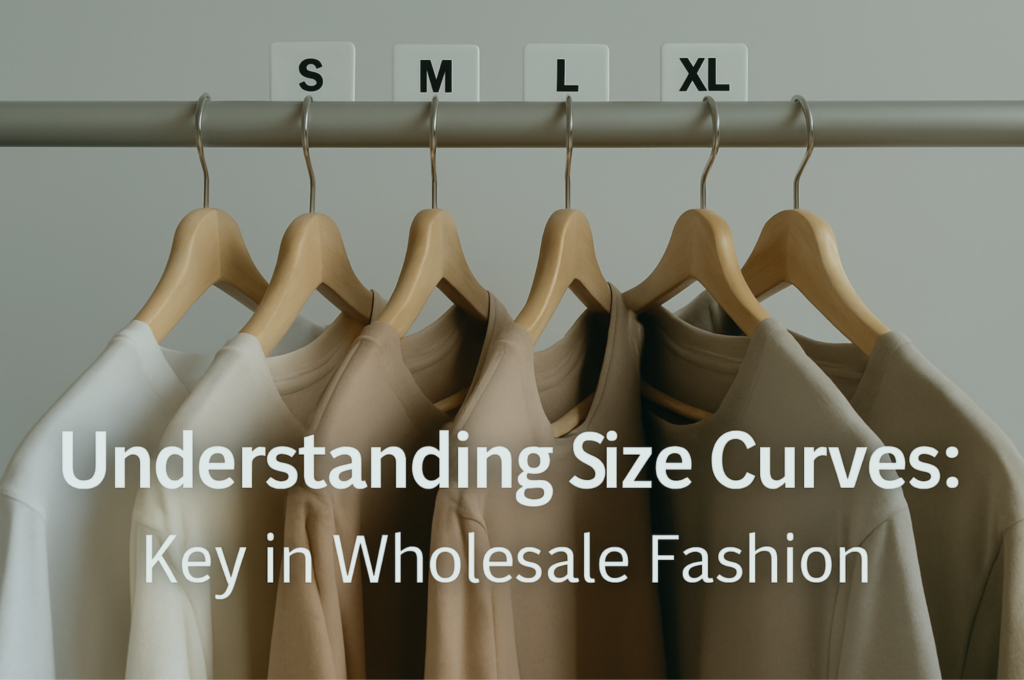Understanding Size Curves: Key in Wholesale Fashion
03 June 2025

03 June 2025

Understanding size curves is critical if you’re buying fashion inventory in bulk – without it, you’re flying blind.
One wrong curve can tank your resale margins, clog your warehouse with unsellable sizes, and kill customer trust.
Here’s the straight answer: understanding size curves in wholesale is one of the most overlooked levers for boosting ROI in fashion distribution.
In this guide, we’ll break down what size curves actually are, how they work in off-price fashion, and how Take Off helps serious B2B buyers use them to reduce risk and make smarter buying decisions.
A size curve is the distribution of sizes in a bulk order.
It tells you how many units of each size are included in the total pack.
Example:
If you’re ordering 100 T-shirts and the curve is 1-2-2-2-1 across S to XL, that’s your ratio.
Your breakdown might look like:
Not all curves are this balanced. In off-price fashion, they often skew due to leftover sizes, category differences, or brand-specific standards.
There are three curve types buyers need to watch for:
Curve formats also differ:
These curves vary by gender, region, product category, and brand.
This isn’t just a data point – it’s your inventory map. Size curves affect:
For example, if your main customer base skews toward medium sizes, and you get a curve loaded with XS and XL – those units won’t move.
Even a 20% mismatch can lead to overstock markdowns, dead inventory, and margin erosion.
Resellers buying for multiple storefronts or platforms (e.g. online + retail) must plan curve splits carefully.
Off-price buyers also face non-trend-aligned stock, meaning you can’t rely on trend-based size guides.
You need hard data – and support from your supplier – to make sure you’re buying the right curve for your resale channel.
Understanding current resale trends can help you better anticipate demand, and tailor your size curves for maximum sell-through. For a deep dive, check out our latest guide to resale fashion trends in 2025.
Line sheets show you what’s included – but most buyers skim the size curve section.
That’s a mistake.
With Take Off, every HD line sheet comes with detailed product metadata, including:
Here’s what to look for:
Understanding this data helps you avoid mismatched inventory – and lets your team plan sales, logistics, and channel splits in advance.
Strong supplier relationships are key to getting accurate size curve data and smooth order processing. Learn how to build effective partnerships in our article on improving supplier relationships.
1. Apparel (Tops, Bottoms, Outerwear)
2. Footwear
3. Accessories
4. Gender Splits
5. Delivery Window Logic (Take Off Specific)
Take Off doesn’t use trend-based tagging. Instead, inventory is organized by delivery window.
This is key: size curves align with what’s available for shipment in that period – helping buyers sync stock intake to their seasonal needs.
Size curve management is baked into Take Off’s wholesale process:
Buyers with large-volume needs (>500 pcs) – reach out through our contact page.
Smaller stock buyers (<500 pcs) – explore curated packs on Bundlex.
Take Off’s streamlined process makes managing size curves and inventory simple – learn more about our approach to exclusive European wholesale fashion here.
.
Mistake 1: Assuming All Curves Are the Same
Always ask for the actual curve, not an assumed “standard.”
Mistake 2: Not Adjusting for Region
German buyers vs Italian boutiques? Size preferences change – curves should match.
Mistake 3: Ignoring Historic Performance
Check past sell-through to guide curve selection for repeat buys.
Mistake 4: Treating Bundled Offers Like Retail Packs
Wholesale bundles need unpacking. Curves often vary inside mixed lots.
Mistake 5: Applying Full-Price Logic to Off-Price
Off-price inventory skews differently. Take Off structures curves around what’s available – not idealised size ranges.
Explore best practices in our article on off-price fashion sourcing.
What is the standard size curve for fashion wholesale?
There’s no universal standard – it varies by brand, region, and category. Take Off includes exact curve data in every proposal.
Can I request a custom size curve for my order?
Yes. For larger volumes, use the Contact Page to discuss requirements with our team.
How do I access product curves if there’s no public catalogue?
Bundlex lets you browse small packs.
Are curves the same for menswear and womenswear?
Not at all. Menswear tends to have tighter curves. Womenswear varies more and often skews toward mid-range sizes.
Do size curves affect shipping or packaging?
Yes. Incorrect curves can cause repackaging delays and increase export costs. Take Off plans logistics based on the accepted curve.
Buying more than 500 pieces?
Request a tailored proposal with full size curve metadata and structured delivery planning.
Buying under 500?
Explore Bundlex for curated stock packs with smart size distribution.